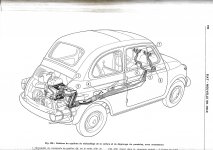The thermostat flap hinge on my Giardi is coming undone, fixing it properly looks like an engine-out job, which got me thinking.
Air cooled bikes have much more efficient finning, and don't have or need a thermostat.
When the weather's cold is when I open the cabin heat flap, thermically this must be the equivalent of an open thermostat flap (when you'd imagine it closed).
As for the engine warm-up period, if a big-finned bike engine can cope with it, wouldn't the Fiat small-finned engine warm up even faster, thermostat or no thermostat ?
So doesn't it make sense to just lock the flap open, or I am missing some subtle point whereby the thermostat is not a bit of heat management overkill ?
Air cooled bikes have much more efficient finning, and don't have or need a thermostat.
When the weather's cold is when I open the cabin heat flap, thermically this must be the equivalent of an open thermostat flap (when you'd imagine it closed).
As for the engine warm-up period, if a big-finned bike engine can cope with it, wouldn't the Fiat small-finned engine warm up even faster, thermostat or no thermostat ?
So doesn't it make sense to just lock the flap open, or I am missing some subtle point whereby the thermostat is not a bit of heat management overkill ?


